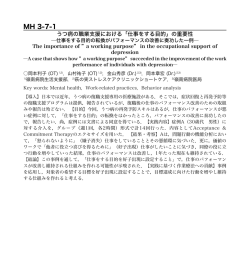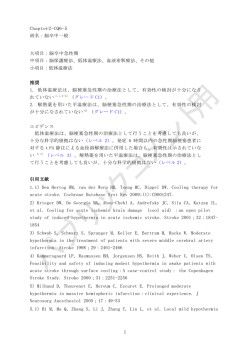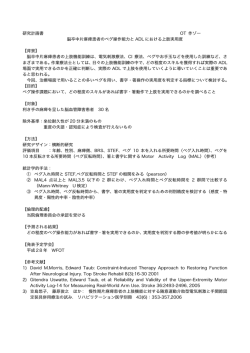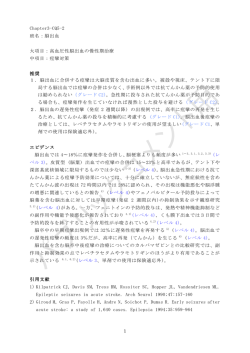
1 Chapter1-11.1 班名:脳卒中一般 大項目:脳卒中一般の管理 中項目
Chapter1-11.1 班名:脳卒中一般 大項目:脳卒中一般の管理 中項目:脳卒中後のうつ 推奨 1. 脳卒中後に高率に出現するうつは、希死念慮と関連し、認知機能や身体機能、日常 生活動作(ADL)を障害する因子となるため、積極的に発見に努めるべきである(グ ン ト用 レード A)。 2. 脳卒中後抑うつ状態に対する薬物治療は、うつ症状や身体機能の改善が期待でき るため、推奨される。(グレード B) エビデンス 一般に脳卒中では 33%(18〜62%)にうつ(うつ状態)を合併し、大うつは 23〜34%、 小うつは 14〜26%に認められる 1-7, 7.1) (レベル 2)。脳卒中後うつは、希死念慮の出現 7.2-7.5) メ や自殺の頻度が 2 倍になることとの関連が強いことから (レベル 3)、倫理的観 点からも積極的にうつの発見に努めるべきである。 すい 5) いが 8,9) コ うつなどの精神疾患の既往例や日常生活動作(ADL)の高度障害例ではうつを生じや (レベル 4)。障害部位としては、左大脳半球病変で生じやすいとする報告が多 7,10) (レベル 4)。脳出血例でう ク (レベル 4)、左右差はないとする報告もある つを呈したものは、前頭葉の脳血流が低下しているとの報告もある 11) (レベル 4)。う つを合併すると、認知機能が障害され、ADL の回復が悪く、死亡率も3倍高いとされる (レベル 3)。うつが改善すると認知機能や ADL も改善するとの報告もある ベル 4)。 リッ 12-14) 15) (レ 抗うつ薬の効果を検討した研究では、うつや身体機能の改善効果が認められている が 16-19、19.1) (レベル 2)、ADL や認知機能の改善効果は認めないとの報告もある 18,19) (レ 20.1) 20, ブ ベル 2)。また、抗うつ薬投与によるうつ発症の明らかな予防効果は認められていない (レベル 2)。 パ 引用文献 1) Starkstein SE, Fedoroff JP, Price TR, Leiguarda R, Robinson RG. Apathy following cerebrovascular lesions. Stroke 1993;24:1625-1630 2) Schwartz JA, Speed NM, Brunberg JA, Brewer TL, Brown M, Greden JF. Depression in stroke rehabilitation. Biol Psychiatry 1993;33:694-699 3) Fuh JL, Liu HC, Wang SJ, Liu CY, Wang PN. Poststroke depression among the Chinese elderly in a rural community. Stroke 1997;28:1126-1129 4) Neau JP, Ingrand P, Mouille-Brachet C, Rosier MP, Couderq C, Alvarez A, et 1 al. Functional recovery and social outcome after cerebral infarction in young adults. Cerebrovasc Dis 1998;8:296-302 5) Pohjasvaara T, Leppavuori A, Siira I, Vataja R, Kaste M, Erkinjuntti T. Frequency and clinical determinants of poststroke depression. Stroke 1998;29:2311-2317 6) Kauhanen M, Korpelainen JT, Hiltunen P, Brusin E, Mononen H, Maatta R, et al. Poststroke depression correlates with cognitive impairment and neurological deficits. Stroke 1999;30:1875-1880 7) Kim JS, Choi-Kwon S. Poststroke depression and emotional incontinence: ン ト用 correlation with lesion location. Neurology 2000;54:1805-1810 7.1) Hackett ML, Yapa C, Parag V, Anderson CS. Frequency of depression after stroke. A systematic review of observational studies. Stroke 2005;36:1330-1340 7.2) Kishi Y, Robinson RG, Kosier JT. Suicidal plans in patients with stroke: comparison between acute-onset and delayed-onset suicidal plans. Int Psychogeriatr 1996;8:623-624 7.3) Teasdale TW, Engberg AW. Suicide after a stroke: a population study. J メ Epidemiol Community Health 2001;55:863-866 7.4) Fuller-Thomson E, Tulipano MJ, Song M. The association between depression, コ suicidal ideation, and stroke in a population-based sample. Int J Stroke 2012;7:188-194 ク 7.5) Santos CO, Caeiro L, Ferro JM, Fiqueira ML. A study of suicidal thoughts in acute stroke patients. J Stroke Cerebrovasc Dis 2012;21:749-754 8) Robinson RG, Lipsey JR, Bolla-Wilson K, Bolduc PL, Pearlson GD, Rao K, et al. リッ Mood disorders in left-handed stroke patients. Am J Psychiatry 1985;142:1424-1429 9) Shimoda K, Robinson RG. The relationship between poststroke depression and lesion location in long-term follow-up. Biol Psychiatry 1999;45:187-192 ブ 10) Singh A, Herrmann N, Black SE. The importance of lesion location in poststroke depression: a critical review. Can J Psychiatry 1998;43:921-927 11) 政田哲也, 眞壁哲夫, 國塩勝三, 他. 脳出血後のうつ状態と SPECT による脳血流 パ の検討. BRAIN and NERVE: 神経研究の進歩 2007;59:165-168 12) Starkstein SE, Robinson RG, Price TR. Comparison of patients with and without poststroke major depression matched for size and location of lesion. Arch Gen Psychiatry 1988;45:247-252 13) Morris PL, Robinson RG, Andrzejewski P, Samuels J, Price TR. Association of depression with 10-year poststroke mortality. Am J Psychiatry 1993;150:124-129 14) Ramasubbu R, Robinson RG, Flint AJ, Kosier T, Price TR. Functional impairment 2 associated with acute poststroke depression: the Stroke Data Bank Study. J Neuropsychiatry Clin Neurosci 1998;10:26-33 15) Kimura M, Robinson RG, Kosier JT. Treatment of cognitive impairment after poststroke depression: a double-blind treatment trial. Stroke 2000;31:1482-1486 16) Andersen G, Vestergaard K, Lauritzen L. Effective treatment of poststroke depression with the selective serotonin reuptake inhibitor citalopram. Stroke 1994;25:1099-1104 17) Dam M, Tonin P, De Boni A, Pizzolato G, Casson S, Ermani M, et al. Effects ン ト用 of fluoxetine and maprotiline on functional recovery in poststroke hemiplegic patients undergoing rehabilitation therapy. Stroke 1996; 27:1211-1214 18) Robinson RG, Schultz SK, Castillo C, Kopel T, Kosier JT, Newman RM, et al. Nortriptyline versus fluoxetine in the treatment of depression and in short-term recovery after stroke: a placebo-controlled, double-blind study. Am J Psychiatry 2000;157:351-359 19) Wiart L, Petit H, Joseph PA, Mazaux JM, Barat M. Fluoxetine in early poststroke メ depression: a double-blind placebo-controlled study. Stroke 2000;31:1829-1832 コ 19.1) Mead GE, et al. Selective serotonin reuptake inhibitors for stroke recovery. A systematic review and meta-analysis.Stroke 44: 844-55, 2013. ク 20) Palomaki H, Kaste M, Berg A, Lonnqvist R, Lonnqvist J, Lehtihalmes M, et al. Prevention of poststroke depression: 1 year randomised placebo controlled double blind trial of mianserin with 6 month follow up after therapy. J Neurol リッ Neurosurg Psychiatry 1999;66:490-494 20.1) Hackett ML, Anderson CS, House AO. Management of depression after stroke. パ ブ A systematic review of pharmacological therapies. Stroke 2005;36:1092-1097 3
© Copyright 2025



